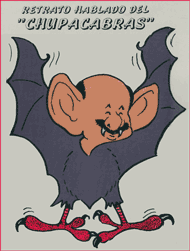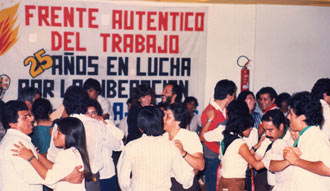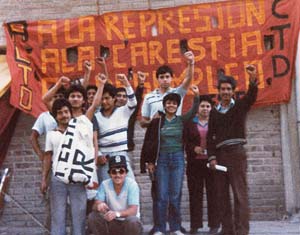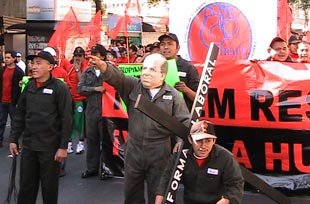
From the Mexican Miracle to the Mexican Mess
Overseeing a mixed-economy, made up of a growing state- sector and a private sector including both Mexican and U.S. capital, the Mexican government adopted a development program of “substitution of imports industrialization.” That is, the country would develop economically through the production of products previously imported from other countries. The substitution of imports produced the Mexican miracle of the 1940s-1960s, with growth rates of over five or six percent. Mexico’s economy grew tremendously, but not fast enough to keep up with either its own population or with foreign competition from countries and Europe, Latin America or Asia. Countries like Brazil and Indonesia strode ahead while Mexico–doing well, but not well enough–began to fall behind the curve of economic development in the industrializing countries.

The situation began to become critical in the 1970s and early 1980s when president Jose Lopez Portillo decided to use newly discovered oil reserves to finance Mexican economic development. Lopez Portillo’s government pumped and sold oil in fantastic quantities, and used its projected oil revenue as collateral on $100 billion in loans for both industrial infrastructure and for social programs. However, when the price of oil collapsed in 1982, Mexico found that it could not pay its debts. So in August 1982, finance minister Jesus Silva Herzog was dispatched to New York to explain that Mexico was unable to pay its debts.
Enter the IMF and the World Bank
At that point the International Monetary Fund (IMF) and the World Bank became key players in Mexico, working New York and European bankers and with the new technocratic presidents–Miguel de la Madrid, Carlos Salinas de Gortari and Ernesto Zedillo–to impose a new economic order on Mexico. The heart of the new program was privatization and deregulation, free trade and foreign investment, and cutbacks in government spending for social programs.
Mexico signed several agreements with the International Monetary Fund and reached agreement with New York and European bankers to repay old loans and negotiate new ones. The World Bank helped to develop plans to privatize various industries. European, Japanese, Korean and most important U.S. multinational corporations expanded investments in Mexico. Under President Salinas, Mexico’s great auction began in earnest with the sale of Telefonos de Mexico (TELMEX) to a private consortium headed by Carlos Slim, but including Southwest Bell Telephone. Between 1988 and 1994, Salinas sold off about 1,000 of Mexico’s 1,100 state firms. Under president Zedillo, the financial end of the Social Security pension system was privatized, as were the railroads.

As part of this process Mexico joined the General Agreement on Trade and Tariffs (GATT) and signed the North American Free Trade Agreement (NAFTA) with Canada and the United States. Throughout the 1980s and 1990s Mexico was forced to give up its nationalized industries and national trade barriers and become part of the North American bloc dominated by the United States.
Mexico’s economy was transformed in the 1980s and 1990s into an export platform, integrated into the North American bloc dominated by the United States. U.S. multinational corporations – and to a much lesser extent other foreign capital – established about 3,500 maquiladora factories employing almost one million workers mostly on the northern border of Mexico. Corporations such as Ford, Chrysler and General Motors, General Electric and many others built factories employing tens of thousands of Mexican workers producing automobiles, auto parts, electrical and electronic goods for sale abroad. In these maquiladoras, Mexican workers earn between US$3.000 and US$5.00 per day. In most industries Mexican wages are about 1/10th those of U.S. workers.
The Mexican Political System
Since the end of the violent phase of the Mexican Revolution in 1920 or at least since its founding in 1928, Mexico has been ruled continuously (under various names) by the state-party, today called the Institutional Revolutionary Party (PRI). Until quite recently the PRI has held controlled the Presidency, the Senate, the House of Representatives, the Supreme Court, almost all governorships and mayoralties throughout the country.
The PRI controlled the labor unions through the Congress of Labor (CT) and the Confederation of Mexican Workers (CTM) and other “official” labor federations (FSTSE, CROM, CROC). The PRI also controlled he peasant organizations through the National Peasant Federation (CNC) and the public employees and self- employed through the National Confederation of Popular Organizations (CNOP). Students had to join the PRI controlled student organizations. Virtually every social organization of any importance had to be affiliated with the ruling party.
Employer organizations, on the other hand, were affiliated directly to the Mexican state (rather than the ruling party). All employers had to join the various chambers of commerce and industry sponsored by the government. Only in the past twenty years have the employer organizations established greater independence.
The Mexican government and the Institutional Revolutionary Party proved to be extremely successful in combining repression and coaptation. When workers, peasants, or the urban poor rebelled, the most intransigent elements would be repressed, while the government-party incorporated the moderate opposition. But the system always depended on a good deal of violence.
Since the Revolution, the government and the state party have used the Army, the police, the Secretary of the Interior (Gobernacion) which controls the political police to control the society. The Army and the police have often been criticized by organizations such as Amnesty International and Americas Watch for their use of arbitrary arrest, kidnapping, torture, and murder.
Years of crisis loosen PRI grip on government
The Mexican system began to change after the 1968 Army massacre of students at Tlatelolco. Many Mexicans gradually began to become disaffected from the Institutional Revolutionary Party during the 1970s and 80s. The 1985 earthquake in Mexico City was another turning point, as many people organized rescue and relief efforts independently of the party. Some speak of that moment as the birth of Mexico’s modern “civil society.” The Mayan Indian uprising of January 1994, led by the Zapatista Army of National Liberation, also created a political crisis for the PRI, since it called into question the government’s economic and social policies. President Ernesto Zedillo’s devaluation of the peso in December of 1994 made 1995 and 1996 the worst years of economic crisis for Mexico since the 1920s and further undermined support for the ruling party.

So for twenty years, things had been changing politically. During the 1980s many people in northern Mexico and in the Yucatan began to vote for the conservative National Action Party (PAN). In 1988, most observers believe that Cuauhtemoc Cardenas, candidate of the left-of-center National Democratic Front probably won the election, though the government of President de la Madrid refused to recognize his victory. Instead, the PRI’s candidate Carlos Salinas de Gortari became president. In 1994 Cardenas ran for president again, but came in third behind the PRI and PAN candidates. But Cardenas and his supporters went on to found the Party of the Democratic Revolution (PRD) which became an important political force.
In the elections held in the summer of 1997, for the first time the PRI lost control of the lower house to the conservative National Action Party (PAN) and the left-of-center Party of the Democratic Revolution (PRD). At the same time, Cuauhtemoc Cardenas was elected the mayor of Mexico City, making him a contender for the presidency in 2000. Although political sympathy in the country appeared fairly evenly split between the PRI, the PAN and the PRD, as it increasingly appeared that Cardenas could not win, many on the left voted for the PAN, exercising what they termed a “voto útil” with the belief that breaking the control of the PRI would provide greater political space. Unfortunately, the governments of Vicente Fox and Felipe Calderón have proven worse in some ways than the PRI, paving the way for what many believe will be a return to power.
History of the UE’s relationship with the FAT federation in Mexico
